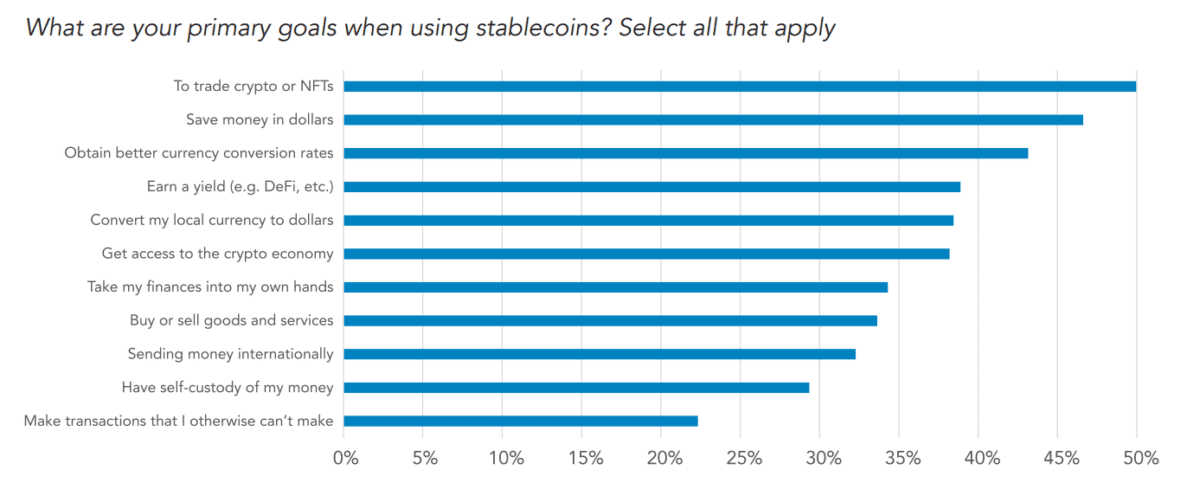Stablecoins in Emerging Markets: Expanding into Everyday Use, Including Exchange, Payment, and Cross-Border Transactions
Stablecoins are Growing in Emerging Markets: A Survey
A recent survey on stablecoin usage in emerging markets reveals that adoption continues to grow, even during recent market downturns. In five emerging market countries, people are no longer solely using stablecoins for crypto trading. The most popular non-trading use cases include currency exchange, making payments, remittances, and receiving salaries.
This survey was conducted by payment giant Visa, venture capital firm Castle Island Ventures, Brevan Howard Digital (the digital asset arm of macro hedge fund Brevan Howard), and data firm Artemis, via YouGov between May 29th and June 13th, 2024.
Nic Carter, General Partner at Castle Island, told The Block that the report was commissioned due to a lack of data on how people are actually using stablecoins around the world, especially in emerging markets. He believes the report provides valuable insights into real-world use cases of stablecoins.
With nearly $170 billion worth of stablecoins currently in circulation, the authors note that these tokens, often pegged to the US dollar, are "undoubtedly" the "killer app" for crypto. After removing noise from MEV trades, arbitrage, and lending activities, as well as other obviously inorganic use cases like internal exchange transfers, the researchers conservatively estimate that $3.7 trillion worth of value was settled through stablecoins in 2023.
The first half of 2024 saw approximately $2.62 trillion worth of value settled through stablecoins, suggesting that stablecoin usage is growing. At this rate, the total value settled in 2024 could reach $5.28 trillion.

Source: Castle Island Ventures
Notably, stablecoin volume has grown "steadily" throughout the market downturn, according to the survey. This suggests that stablecoins have reached new users who are using them for more than just trading settlement. Additionally, 57% of users said they had increased their stablecoin usage in the past year, and 72% expect their usage to further increase in the next year.
Common Use Cases
According to the survey, the most popular use cases for stablecoins, outside of crypto trading, include currency exchange, making payments, remittances, and receiving salaries. The report states:
"While the most prevalent use case among the sample is trading crypto or NFTs, other non-crypto uses are not far behind. Overall, 47% of respondents mentioned saving in USD as one of their key objectives, 43% mentioned better currency exchange rates, and 39% pointed to earning yield. The findings are clear: Non-crypto use cases represent a significant proportion of stablecoin usage patterns in the surveyed countries."

Source: Castle Island Ventures
Stablecoin usage varies across different regions. For instance, in Turkey, the most prevalent objective is to earn yield through stablecoins, followed by crypto trading. For Nigerians, depositing in USD via stablecoins is the primary objective, followed by crypto trading and obtaining better exchange rates.
Furthermore, Pintu, one of Indonesia's largest cryptocurrency platforms, reports that users utilize stablecoins for B2B payments and arbitrage:
"For many Indonesian users, stablecoins are more accessible than bank-provided USD services. Local crypto exchanges have simpler registration requirements than creating a USD bank account, thus presenting a lower barrier to entry for users."
Meanwhile, users of Yellowcard, Africa's largest cryptocurrency on-ramp, report using stablecoins for foreign exchange trading due to capital controls that often restrict international transactions. The company adds: "Therefore, people and businesses are turning to stablecoins to maintain payment flows, bring in imports, keep operations running, and support families."
